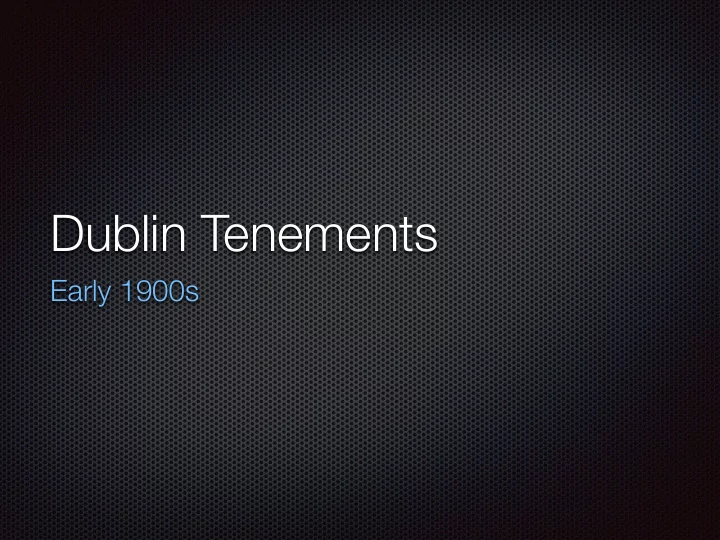

Dublin Tenements Early 1900s
Worst Housing Conditions in Europe Extensive slums not limited to ghettos Wealthy moved from city centre to suburbs and huge, red-brick Georgian houses in previously fashionable areas were taken over by the rent-paying poor
Poverty and Overcrowding In Henrietta Street, 835 people lived in only 15 houses Dozens of families could live in a single house Most were lucky to have one room Disease, malnutrition and filthy conditions prevailed
Unemployment Most families depended on casual labour Unemployment was rife Families lived in extreme poverty
Sean O’Casey 1880-1964 Born John Casey Youngest of thirteen children, of whom only five survived Lower-class Protestant Father died and family had to move to a tenement
Culture and Politics Death of Parnell resulted in the break-up of the groups he had held together Political division and squabbling about home rule and independence turned many away from politics and towards other ways of expressing themselves The Anglo-Irish literary revival, led by Yeats, was hugely important. Old Irish legends and heroic tales were retold and romanticised Yeats et al believed that a cultural revival would create a new sort of nation
Gaelic League and GAA O’Casey joined both revivalist organisations Taught himself Irish and changed his name to Seán Played hurling Believed that culture needed to be de- Anglicised
O’Casey fell out with the Gaelic league over religious issues and joined the IRB (Irish Republican Brotherhood) Patrick Pearse believed war with England was necessary O’Casey disagreed and he presents Pearse in a deliberately dramatically ironic way: giving fiery and stirring speeches in a pub
Larkin, Connolly, the Trade Unions and the Lockout O’Casey looked up to Larkin who acted to help the poor people of Ireland. He became a leader in the ITGWU and lost his job as a result of his support for Larkin
O’Casey again came into conflict with the church when it stepped in to stop the sending of strikers’ children to supporters’ homes in England The church felt the children would be converted to the ‘pagan’ ways of their temporary homes and thus forced strikers to keep them in abject poverty in Ireland
The Irish Citizen Army: Plight of the Workers becomes Nationalism Formed by the ITGQU to protect members from the police Larkin was imprisoned in the US and James Connolly took over O’Casey fell out with him over uniforms for the Irish Citizen Army Peter’s uniform in the play is an exaggerated version of the Citizen Army uniform O’Casey resigned when Countess Markievicz joined
Controversy When the play was first staged, it was greeted by riots O’Casey refused to rewrite history to venerate the leaders James Connolly had ordered his men to fire at looters during the rising Most ordinary Irish people were against the rising and even aided those who fought the rebels The execution of the leaders changed everything and they became heroes
Recommend
More recommend